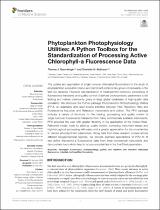 ResearchSpace
ResearchSpace
Phytoplankton photophysiology utilities: A python toolbox for the standardization of processing active chlorophyll-a fluorescence data
JavaScript is disabled for your browser. Some features of this site may not work without it.
- ResearchSpace
- →
- Research Publications/Outputs
- →
- Journal Articles
- →
- View Item
| dc.contributor.author |
Ryan-Keogh, Thomas J

|
|
| dc.date.accessioned | 2022-05-27T09:27:51Z | |
| dc.date.available | 2022-05-27T09:27:51Z | |
| dc.date.issued | 2021-07 | |
| dc.identifier.citation | Ryan-Keogh, T.J. 2021. Phytoplankton photophysiology utilities: A python toolbox for the standardization of processing active chlorophyll-a fluorescence data. <i>Frontiers in Marine Science, 8.</i> http://hdl.handle.net/10204/12430 | en_ZA |
| dc.identifier.issn | 2296-7745 | |
| dc.identifier.uri | https://doi.org/10.3389/fmars.2021.525414 | |
| dc.identifier.uri | http://hdl.handle.net/10204/12430 | |
| dc.description.abstract | The uptake and application of single turnover chlorophyll fluorometers to the study of phytoplankton ecosystem status and microbial functions has grown considerably in the last two decades. However, standardization of measurement protocols, processing of fluorescence transients and quality control of derived photosynthetic parameters is still lacking and makes community goals of large global databases of high-quality data unrealistic. We introduce the Python package Phytoplankton Photophysiology Utilities (PPU), an adaptable and open-source interface between Fast Repetition Rate and Fluorescence Induction and Relaxation instruments and python. The PPU package includes a variety of functions for the loading, processing and quality control of single turnover fluorescence transients from many commercially available instruments. PPU provides the user with greater flexibility in the application of the Kolber-Prasil-Falkowski model; tools for plotting, quality control, correcting instrument biases and high-throughput processing with ease; and a greater appreciation for the uncertainties in derived photosynthetic parameters. Using data from three research cruises across different biogeochemical regimes, we provide example applications of PPU to fit raw active chlorophyll-a fluorescence data from three commercial instruments and demonstrate tools which help to reduce uncertainties in the final fitted parameters. | en_US |
| dc.format | Fulltext | en_US |
| dc.language.iso | en | en_US |
| dc.relation.uri | https://www.frontiersin.org/articles/10.3389/fmars.2021.525414/full | en_US |
| dc.source | Frontiers in Marine Science, 8 | en_US |
| dc.subject | Chlorophyll fluorescence | en_US |
| dc.subject | Photophysiology | en_US |
| dc.subject | Python toolbox | en_US |
| dc.subject | Fast repetition fluorometry | en_US |
| dc.title | Phytoplankton photophysiology utilities: A python toolbox for the standardization of processing active chlorophyll-a fluorescence data | en_US |
| dc.type | Article | en_US |
| dc.description.pages | 8 | en_US |
| dc.description.note | This is an open access article. | en_US |
| dc.description.cluster | Smart Places | en_US |
| dc.description.impactarea | Ocean Systems and Climate | en_US |
| dc.identifier.apacitation | Ryan-Keogh, T. J. (2021). Phytoplankton photophysiology utilities: A python toolbox for the standardization of processing active chlorophyll-a fluorescence data. <i>Frontiers in Marine Science, 8</i>, http://hdl.handle.net/10204/12430 | en_ZA |
| dc.identifier.chicagocitation | Ryan-Keogh, Thomas J "Phytoplankton photophysiology utilities: A python toolbox for the standardization of processing active chlorophyll-a fluorescence data." <i>Frontiers in Marine Science, 8</i> (2021) http://hdl.handle.net/10204/12430 | en_ZA |
| dc.identifier.vancouvercitation | Ryan-Keogh TJ. Phytoplankton photophysiology utilities: A python toolbox for the standardization of processing active chlorophyll-a fluorescence data. Frontiers in Marine Science, 8. 2021; http://hdl.handle.net/10204/12430. | en_ZA |
| dc.identifier.ris | TY - Article AU - Ryan-Keogh, Thomas J AB - The uptake and application of single turnover chlorophyll fluorometers to the study of phytoplankton ecosystem status and microbial functions has grown considerably in the last two decades. However, standardization of measurement protocols, processing of fluorescence transients and quality control of derived photosynthetic parameters is still lacking and makes community goals of large global databases of high-quality data unrealistic. We introduce the Python package Phytoplankton Photophysiology Utilities (PPU), an adaptable and open-source interface between Fast Repetition Rate and Fluorescence Induction and Relaxation instruments and python. The PPU package includes a variety of functions for the loading, processing and quality control of single turnover fluorescence transients from many commercially available instruments. PPU provides the user with greater flexibility in the application of the Kolber-Prasil-Falkowski model; tools for plotting, quality control, correcting instrument biases and high-throughput processing with ease; and a greater appreciation for the uncertainties in derived photosynthetic parameters. Using data from three research cruises across different biogeochemical regimes, we provide example applications of PPU to fit raw active chlorophyll-a fluorescence data from three commercial instruments and demonstrate tools which help to reduce uncertainties in the final fitted parameters. DA - 2021-07 DB - ResearchSpace DP - CSIR J1 - Frontiers in Marine Science, 8 KW - Chlorophyll fluorescence KW - Photophysiology KW - Python toolbox KW - Fast repetition fluorometry LK - https://researchspace.csir.co.za PY - 2021 SM - 2296-7745 T1 - Phytoplankton photophysiology utilities: A python toolbox for the standardization of processing active chlorophyll-a fluorescence data TI - Phytoplankton photophysiology utilities: A python toolbox for the standardization of processing active chlorophyll-a fluorescence data UR - http://hdl.handle.net/10204/12430 ER - | en_ZA |
| dc.identifier.worklist | 25485 | en_US |





